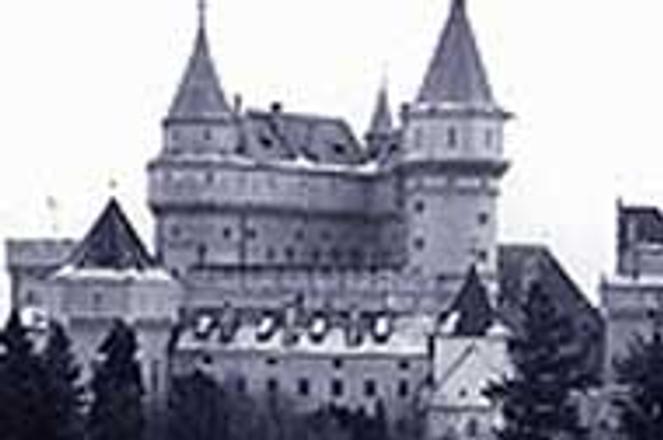Bojnice Castle is open to the public year-round, but is particularly beautiful in the winter.Foto: Matthew Evans
Rising proudly above the forested Strážov Hills of the upper Nitra Valley, Bojnice castle evokes all the most romantic images of knights, damsels, and dragons. The massive structure has it all, from circular towers with neo-gothic detailing and pointed roofs, to the moat encircling the rock on which it rests. It also has an impressive history.
If the sight of Bojnice doesn't leave you speechless, the festive atmosphere the locals generate ought to do the trick. The tour guides, decked out in costumes from the Middle Ages, entertain guests with skits and ceremonies throughout the year. Special visitors stop in for special occasions: at Christmas time, the Three Kings present gifts to the baby Jesus inside the enormous Hunyadyho Hall, adorned with paintings collected by Count Ján Pálffy. Outside the castle walls, families sled down frosty embankments and skate on the frozen moat. Lovers wander around the grounds and through the zoo next door.
The International Ghost Festival, held during the first weekend in May, is another terrific time to visit Bojnice. Crowds gather in the outdoor amphitheater by the castle, which hosts exhibitions ranging from sword fights to birds of prey, where eagles and owls swoop over the crowd for treats from their trainers. Visitors can sample food and drink from booths set up around the castle, while listening to live or recorded music. Meanwhile, mock executions kick off the guided castle tour in the main courtyard. Locals in ghoulish costumes roam the castle trying to spook the visitors.
But the castle itself will be the highlight of your visit at any time of tbe year. What you see today is a product of several stages of construction over the castle's 900-year history. The first written record of a fortress and surrounding settlement dates back to the 1113 charter of the Abbot of Zobor. There, in Latin script, King Solomon confirmed the Benedictine monastery of St. Hypolita, on Zobor mountain near Nitra, as the rightful owner of the fortress. In the 13th century, the Poznanovec family gradually transformed the original wooden fort into a stone fortress with an irregular oval ground-plan.
From the late 13th to 17th centuries, the castle changed hands and looks repeatedly. The ubiquitous Matúš Čák of Trenčín seized ownership in the late 13th century and held on until 1321. Then the Gileth, Leustach and Noffry families had their turns, preserving the basic oval outline of the central living quarters encircling a small courtyard with a well. Zapoásky troops, presumably from Poland, took over and built the mighty walls and towers of the outer fortification in the early 16th Century. The Thurzo family then renovated the castle core into a majestic renaissance palace. Finally, in 1644, King Ferdinand III presented the stronghold to Pavol Pálffy for his assistance against the Turks and rebellious Hungarian nobles. Pálffy made baroque embellishments, including the pristine chapel, with its vaulted and frescoed ceilings.
After a period of stagnation and deterioration which lasted from the late 17th until the mid-19th centuries, Count Ján František Pálffy inherited the structure in 1852. This Pálffy, a great admirer of the chateaux along France's Loire River valley, wanted to create a single architectural statement out of the mishmash of eras represented in Bojnice. So he hired Austrian master architects in 1888 to rebuild the interior in late-Tyrolian gothic style and erected the huge tower on the western corner, forming the contemporary castle outline. Pálffy himself planned many of the decorative details for doors, windows and wall paintings.
Pálffy's massive new romantic home also served as a personal museum for his multicultural fine arts collection. The 17th century wall panelling in the Oriental Hall was imported from Serbia. The same room also houses a richly engraved Indian table, and a blue vase from the Chinese Ming dynasty. The chapel was furnished with a 14th century Italian gothic altar (preserved in another room). He also stocked the palace with paintings and antiques bought at auctions across Europe.
Count Pálffy died in Vienna in 1908, leaving many of his grand plans unrealized. Much of his collections were sold off, a fact difficult to comprehend given the wealth of what survives today. The Count himself joins the collection as the subject of a circular painting at the center of the gold-plated ceiling in the Golden Room. His body lies in a closed sacophagus beside other family members in the tomb near the end of the tour. The intricately carved wall separating the living and sleeping quarters of the Great Hall on the second floor is another highlight. The tour ends 26 meters below the castle in a cave with a mineral spring at its center. Here, visitors can view the castle well from below.
Outside Bojnice, Slovakia's oldest and largest zoo is also worth a look. Among the 2,250 lucky creatures housed on more than 100 acres are 260 species, including African elephants, kangaroos, lions, llamas and the birds of prey used in castle exhibits.


